Unit-2: Derivatives | Assignment
VerifiedAdded on 2022/08/29
|11
|1422
|23
AI Summary
Please not that one is calculus and one is advanced functions and it is clearly indicated in the title.
Contribute Materials
Your contribution can guide someone’s learning journey. Share your
documents today.
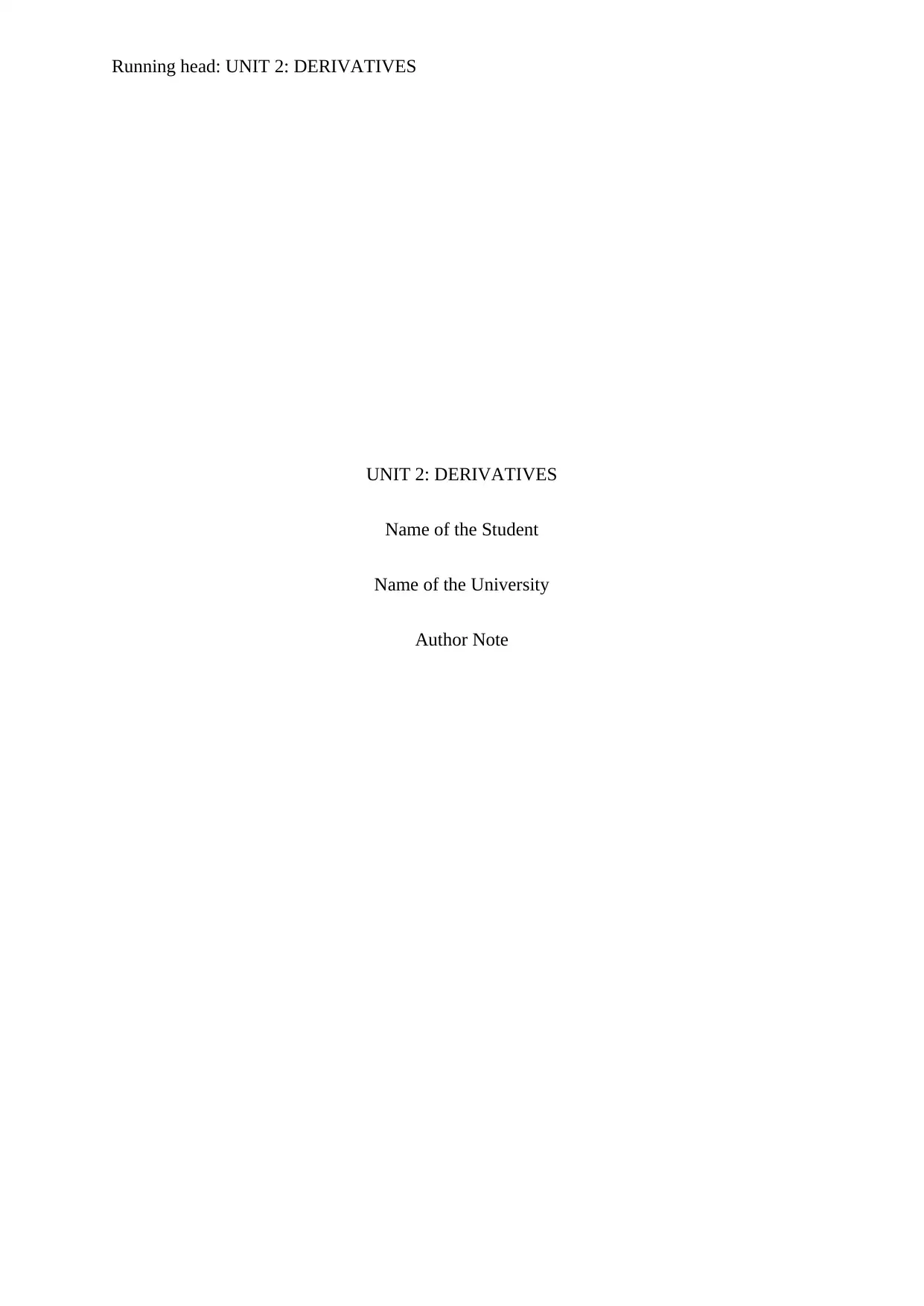
Running head: UNIT 2: DERIVATIVES
UNIT 2: DERIVATIVES
Name of the Student
Name of the University
Author Note
UNIT 2: DERIVATIVES
Name of the Student
Name of the University
Author Note
Secure Best Marks with AI Grader
Need help grading? Try our AI Grader for instant feedback on your assignments.
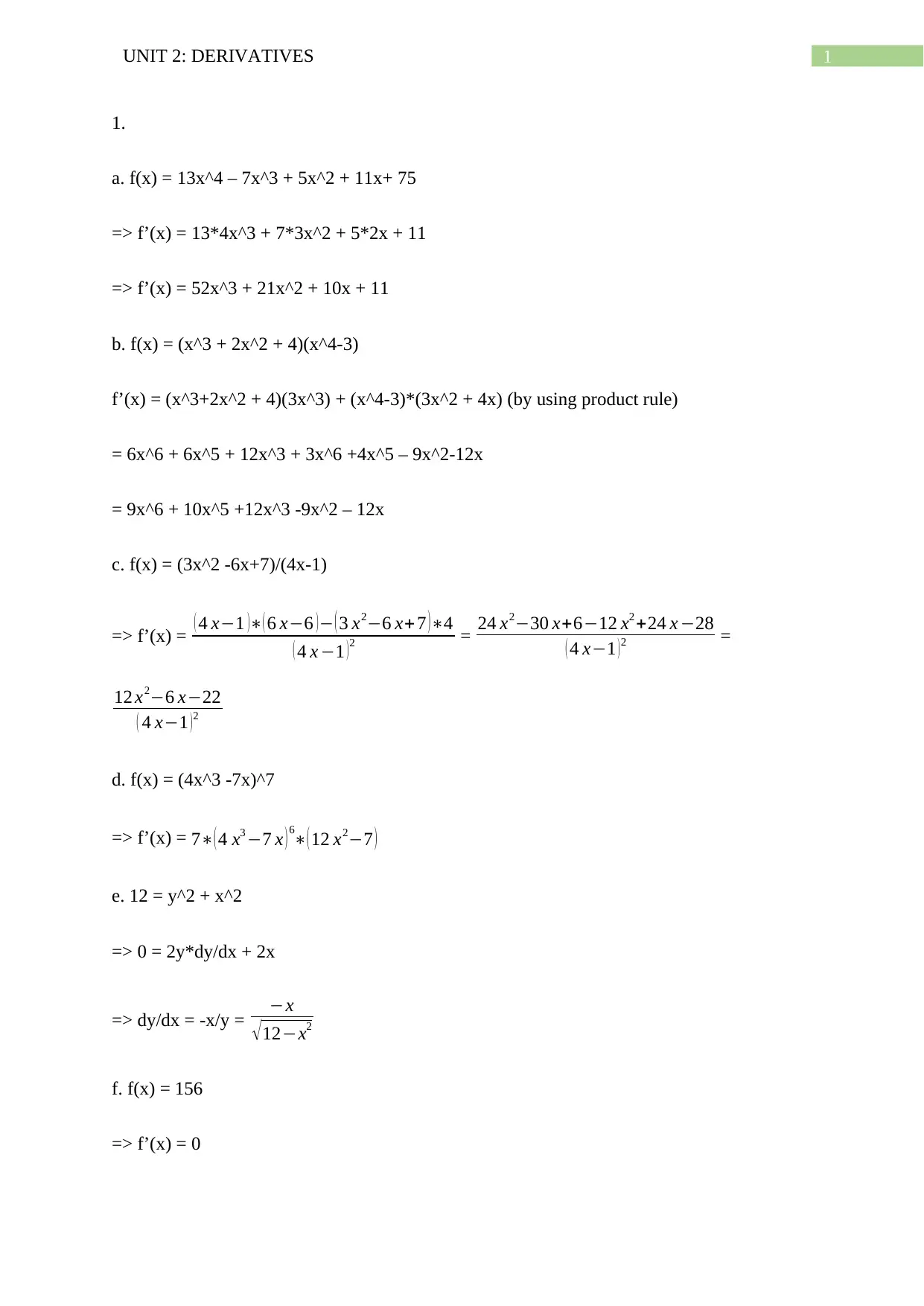
1UNIT 2: DERIVATIVES
1.
a. f(x) = 13x^4 – 7x^3 + 5x^2 + 11x+ 75
=> f’(x) = 13*4x^3 + 7*3x^2 + 5*2x + 11
=> f’(x) = 52x^3 + 21x^2 + 10x + 11
b. f(x) = (x^3 + 2x^2 + 4)(x^4-3)
f’(x) = (x^3+2x^2 + 4)(3x^3) + (x^4-3)*(3x^2 + 4x) (by using product rule)
= 6x^6 + 6x^5 + 12x^3 + 3x^6 +4x^5 – 9x^2-12x
= 9x^6 + 10x^5 +12x^3 -9x^2 – 12x
c. f(x) = (3x^2 -6x+7)/(4x-1)
=> f’(x) = ( 4 x−1 )∗( 6 x−6 )− ( 3 x2−6 x+ 7 )∗4
( 4 x −1 )2 = 24 x2−30 x+6−12 x2 +24 x −28
( 4 x−1 )2 =
12 x2−6 x−22
( 4 x−1 ) 2
d. f(x) = (4x^3 -7x)^7
=> f’(x) = 7∗( 4 x3 −7 x ) 6
∗( 12 x2−7 )
e. 12 = y^2 + x^2
=> 0 = 2y*dy/dx + 2x
=> dy/dx = -x/y = −x
√12−x2
f. f(x) = 156
=> f’(x) = 0
1.
a. f(x) = 13x^4 – 7x^3 + 5x^2 + 11x+ 75
=> f’(x) = 13*4x^3 + 7*3x^2 + 5*2x + 11
=> f’(x) = 52x^3 + 21x^2 + 10x + 11
b. f(x) = (x^3 + 2x^2 + 4)(x^4-3)
f’(x) = (x^3+2x^2 + 4)(3x^3) + (x^4-3)*(3x^2 + 4x) (by using product rule)
= 6x^6 + 6x^5 + 12x^3 + 3x^6 +4x^5 – 9x^2-12x
= 9x^6 + 10x^5 +12x^3 -9x^2 – 12x
c. f(x) = (3x^2 -6x+7)/(4x-1)
=> f’(x) = ( 4 x−1 )∗( 6 x−6 )− ( 3 x2−6 x+ 7 )∗4
( 4 x −1 )2 = 24 x2−30 x+6−12 x2 +24 x −28
( 4 x−1 )2 =
12 x2−6 x−22
( 4 x−1 ) 2
d. f(x) = (4x^3 -7x)^7
=> f’(x) = 7∗( 4 x3 −7 x ) 6
∗( 12 x2−7 )
e. 12 = y^2 + x^2
=> 0 = 2y*dy/dx + 2x
=> dy/dx = -x/y = −x
√12−x2
f. f(x) = 156
=> f’(x) = 0
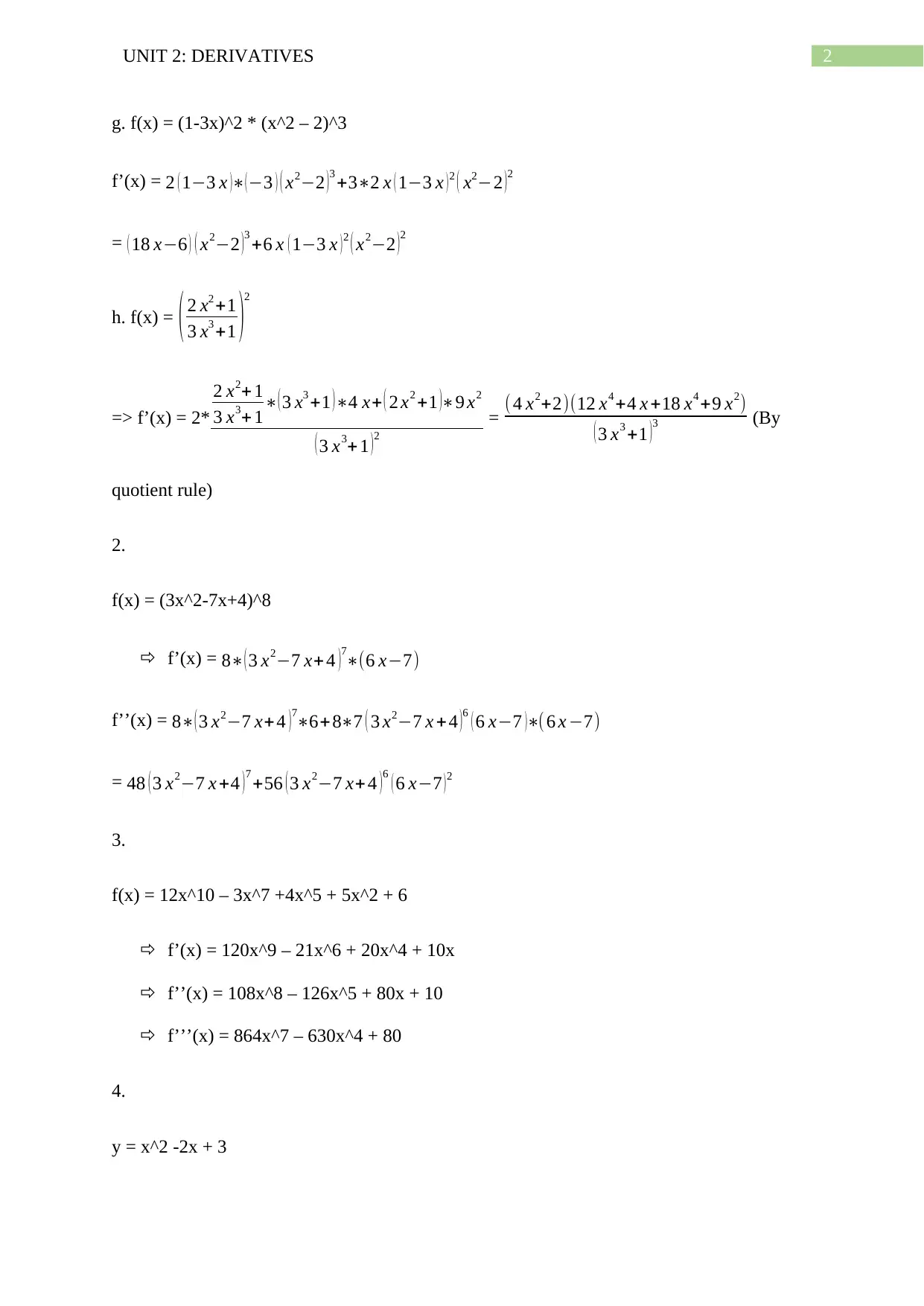
2UNIT 2: DERIVATIVES
g. f(x) = (1-3x)^2 * (x^2 – 2)^3
f’(x) = 2 ( 1−3 x )∗( −3 ) ( x2−2 ) 3
+3∗2 x ( 1−3 x ) 2 ( x2−2 ) 2
= ( 18 x−6 ) ( x2−2 )3
+6 x ( 1−3 x )2 ( x2−2 )2
h. f(x) = ( 2 x2 +1
3 x3 +1 )2
=> f’(x) = 2*
2 x2+ 1
3 x3+ 1∗( 3 x3 +1 ) ∗4 x+ ( 2 x2 +1 )∗9 x2
( 3 x3+ 1 ) 2
= ( 4 x2+2)(12 x4 +4 x +18 x4 +9 x2)
( 3 x3 +1 )3 (By
quotient rule)
2.
f(x) = (3x^2-7x+4)^8
f’(x) = 8∗( 3 x2−7 x+ 4 )
7
∗(6 x−7)
f’’(x) = 8∗( 3 x2−7 x+4 )7
∗6+8∗7 ( 3 x2−7 x +4 )6
( 6 x−7 )∗( 6 x −7)
= 48 ( 3 x2−7 x +4 )7
+56 ( 3 x2−7 x+ 4 )6
( 6 x−7 )2
3.
f(x) = 12x^10 – 3x^7 +4x^5 + 5x^2 + 6
f’(x) = 120x^9 – 21x^6 + 20x^4 + 10x
f’’(x) = 108x^8 – 126x^5 + 80x + 10
f’’’(x) = 864x^7 – 630x^4 + 80
4.
y = x^2 -2x + 3
g. f(x) = (1-3x)^2 * (x^2 – 2)^3
f’(x) = 2 ( 1−3 x )∗( −3 ) ( x2−2 ) 3
+3∗2 x ( 1−3 x ) 2 ( x2−2 ) 2
= ( 18 x−6 ) ( x2−2 )3
+6 x ( 1−3 x )2 ( x2−2 )2
h. f(x) = ( 2 x2 +1
3 x3 +1 )2
=> f’(x) = 2*
2 x2+ 1
3 x3+ 1∗( 3 x3 +1 ) ∗4 x+ ( 2 x2 +1 )∗9 x2
( 3 x3+ 1 ) 2
= ( 4 x2+2)(12 x4 +4 x +18 x4 +9 x2)
( 3 x3 +1 )3 (By
quotient rule)
2.
f(x) = (3x^2-7x+4)^8
f’(x) = 8∗( 3 x2−7 x+ 4 )
7
∗(6 x−7)
f’’(x) = 8∗( 3 x2−7 x+4 )7
∗6+8∗7 ( 3 x2−7 x +4 )6
( 6 x−7 )∗( 6 x −7)
= 48 ( 3 x2−7 x +4 )7
+56 ( 3 x2−7 x+ 4 )6
( 6 x−7 )2
3.
f(x) = 12x^10 – 3x^7 +4x^5 + 5x^2 + 6
f’(x) = 120x^9 – 21x^6 + 20x^4 + 10x
f’’(x) = 108x^8 – 126x^5 + 80x + 10
f’’’(x) = 864x^7 – 630x^4 + 80
4.
y = x^2 -2x + 3
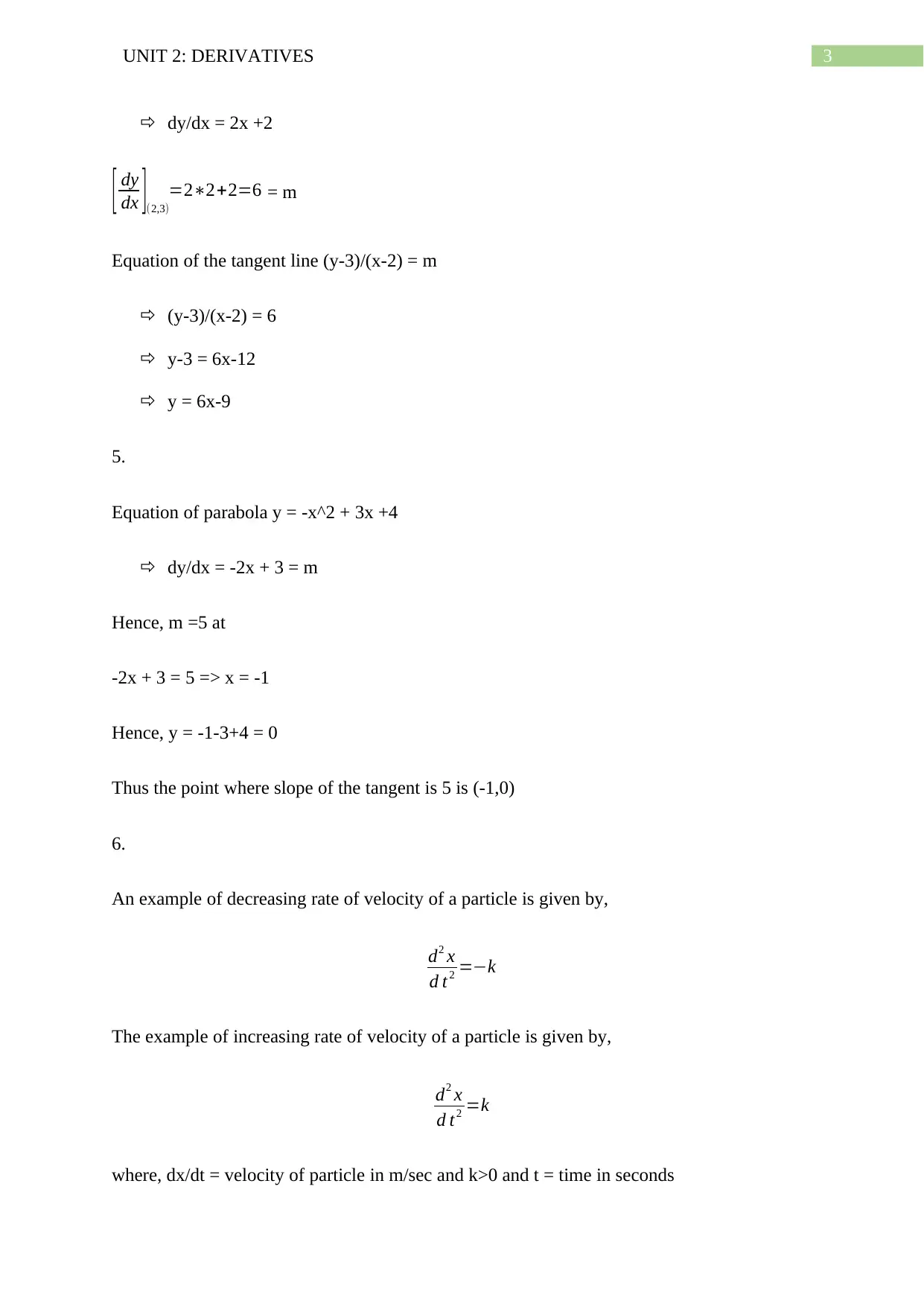
3UNIT 2: DERIVATIVES
dy/dx = 2x +2
[ dy
dx ](2,3)
=2∗2+2=6 = m
Equation of the tangent line (y-3)/(x-2) = m
(y-3)/(x-2) = 6
y-3 = 6x-12
y = 6x-9
5.
Equation of parabola y = -x^2 + 3x +4
dy/dx = -2x + 3 = m
Hence, m =5 at
-2x + 3 = 5 => x = -1
Hence, y = -1-3+4 = 0
Thus the point where slope of the tangent is 5 is (-1,0)
6.
An example of decreasing rate of velocity of a particle is given by,
d2 x
d t2 =−k
The example of increasing rate of velocity of a particle is given by,
d2 x
d t2 =k
where, dx/dt = velocity of particle in m/sec and k>0 and t = time in seconds
dy/dx = 2x +2
[ dy
dx ](2,3)
=2∗2+2=6 = m
Equation of the tangent line (y-3)/(x-2) = m
(y-3)/(x-2) = 6
y-3 = 6x-12
y = 6x-9
5.
Equation of parabola y = -x^2 + 3x +4
dy/dx = -2x + 3 = m
Hence, m =5 at
-2x + 3 = 5 => x = -1
Hence, y = -1-3+4 = 0
Thus the point where slope of the tangent is 5 is (-1,0)
6.
An example of decreasing rate of velocity of a particle is given by,
d2 x
d t2 =−k
The example of increasing rate of velocity of a particle is given by,
d2 x
d t2 =k
where, dx/dt = velocity of particle in m/sec and k>0 and t = time in seconds
Secure Best Marks with AI Grader
Need help grading? Try our AI Grader for instant feedback on your assignments.
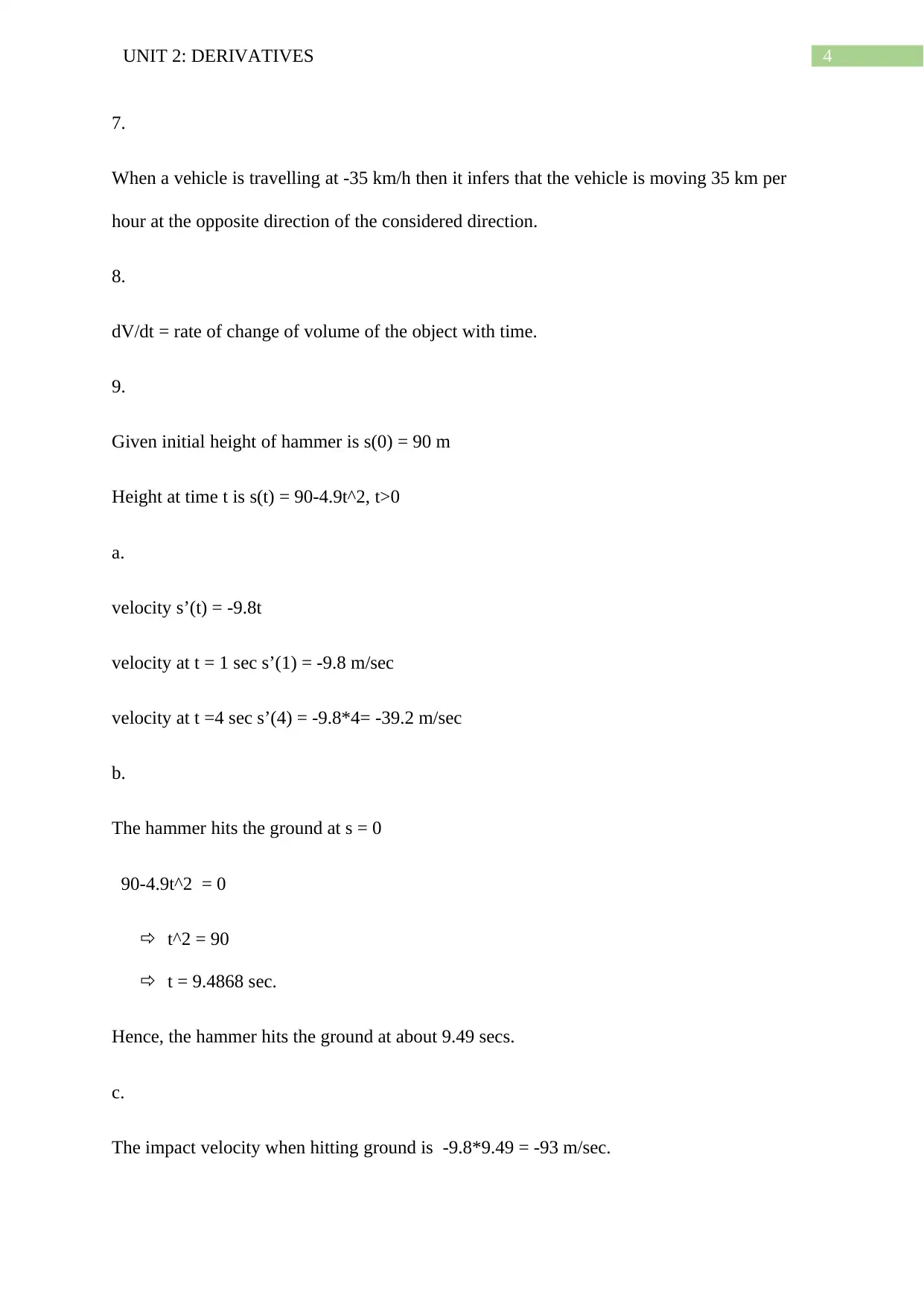
4UNIT 2: DERIVATIVES
7.
When a vehicle is travelling at -35 km/h then it infers that the vehicle is moving 35 km per
hour at the opposite direction of the considered direction.
8.
dV/dt = rate of change of volume of the object with time.
9.
Given initial height of hammer is s(0) = 90 m
Height at time t is s(t) = 90-4.9t^2, t>0
a.
velocity s’(t) = -9.8t
velocity at t = 1 sec s’(1) = -9.8 m/sec
velocity at t =4 sec s’(4) = -9.8*4= -39.2 m/sec
b.
The hammer hits the ground at s = 0
90-4.9t^2 = 0
t^2 = 90
t = 9.4868 sec.
Hence, the hammer hits the ground at about 9.49 secs.
c.
The impact velocity when hitting ground is -9.8*9.49 = -93 m/sec.
7.
When a vehicle is travelling at -35 km/h then it infers that the vehicle is moving 35 km per
hour at the opposite direction of the considered direction.
8.
dV/dt = rate of change of volume of the object with time.
9.
Given initial height of hammer is s(0) = 90 m
Height at time t is s(t) = 90-4.9t^2, t>0
a.
velocity s’(t) = -9.8t
velocity at t = 1 sec s’(1) = -9.8 m/sec
velocity at t =4 sec s’(4) = -9.8*4= -39.2 m/sec
b.
The hammer hits the ground at s = 0
90-4.9t^2 = 0
t^2 = 90
t = 9.4868 sec.
Hence, the hammer hits the ground at about 9.49 secs.
c.
The impact velocity when hitting ground is -9.8*9.49 = -93 m/sec.
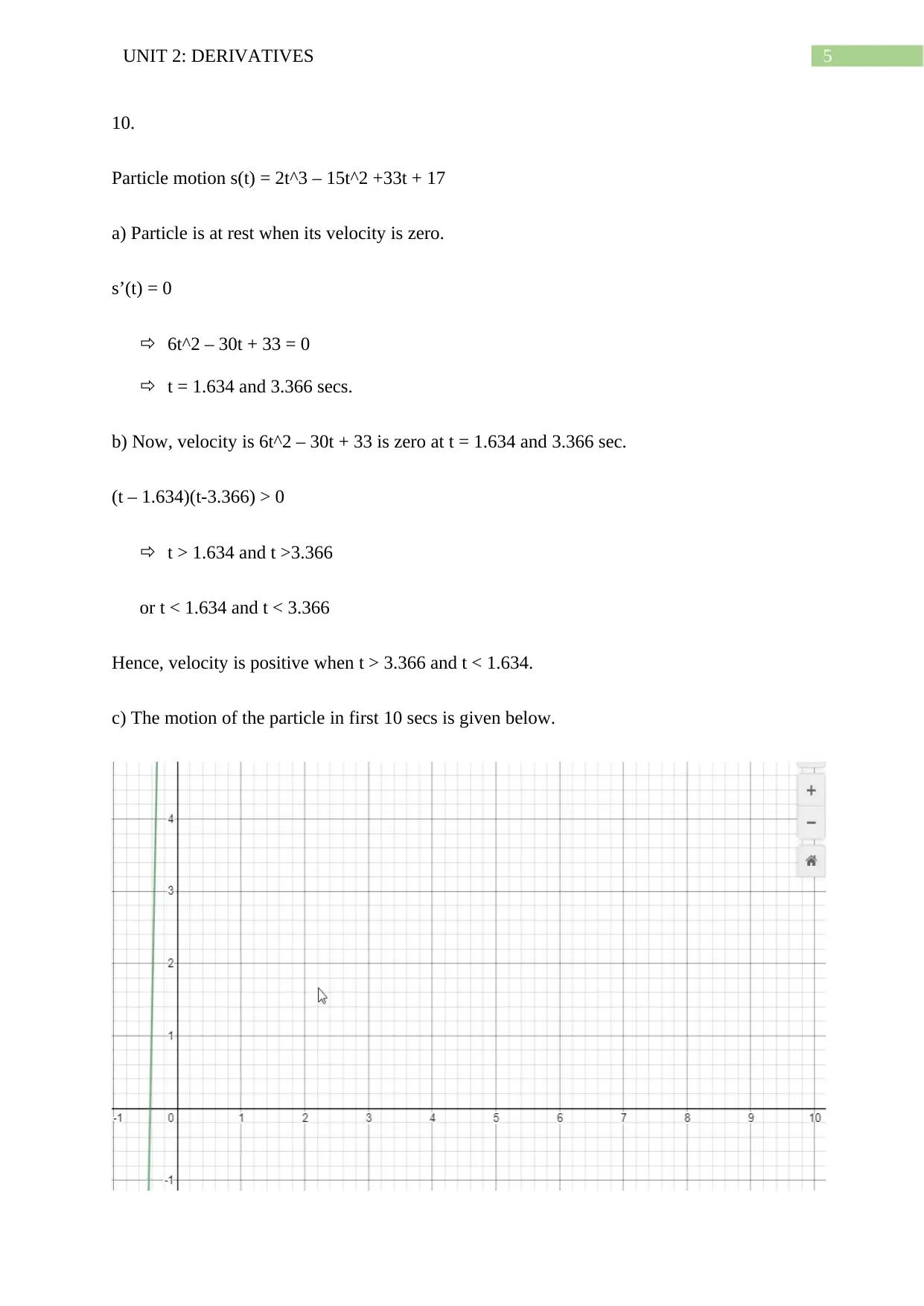
5UNIT 2: DERIVATIVES
10.
Particle motion s(t) = 2t^3 – 15t^2 +33t + 17
a) Particle is at rest when its velocity is zero.
s’(t) = 0
6t^2 – 30t + 33 = 0
t = 1.634 and 3.366 secs.
b) Now, velocity is 6t^2 – 30t + 33 is zero at t = 1.634 and 3.366 sec.
(t – 1.634)(t-3.366) > 0
t > 1.634 and t >3.366
or t < 1.634 and t < 3.366
Hence, velocity is positive when t > 3.366 and t < 1.634.
c) The motion of the particle in first 10 secs is given below.
10.
Particle motion s(t) = 2t^3 – 15t^2 +33t + 17
a) Particle is at rest when its velocity is zero.
s’(t) = 0
6t^2 – 30t + 33 = 0
t = 1.634 and 3.366 secs.
b) Now, velocity is 6t^2 – 30t + 33 is zero at t = 1.634 and 3.366 sec.
(t – 1.634)(t-3.366) > 0
t > 1.634 and t >3.366
or t < 1.634 and t < 3.366
Hence, velocity is positive when t > 3.366 and t < 1.634.
c) The motion of the particle in first 10 secs is given below.
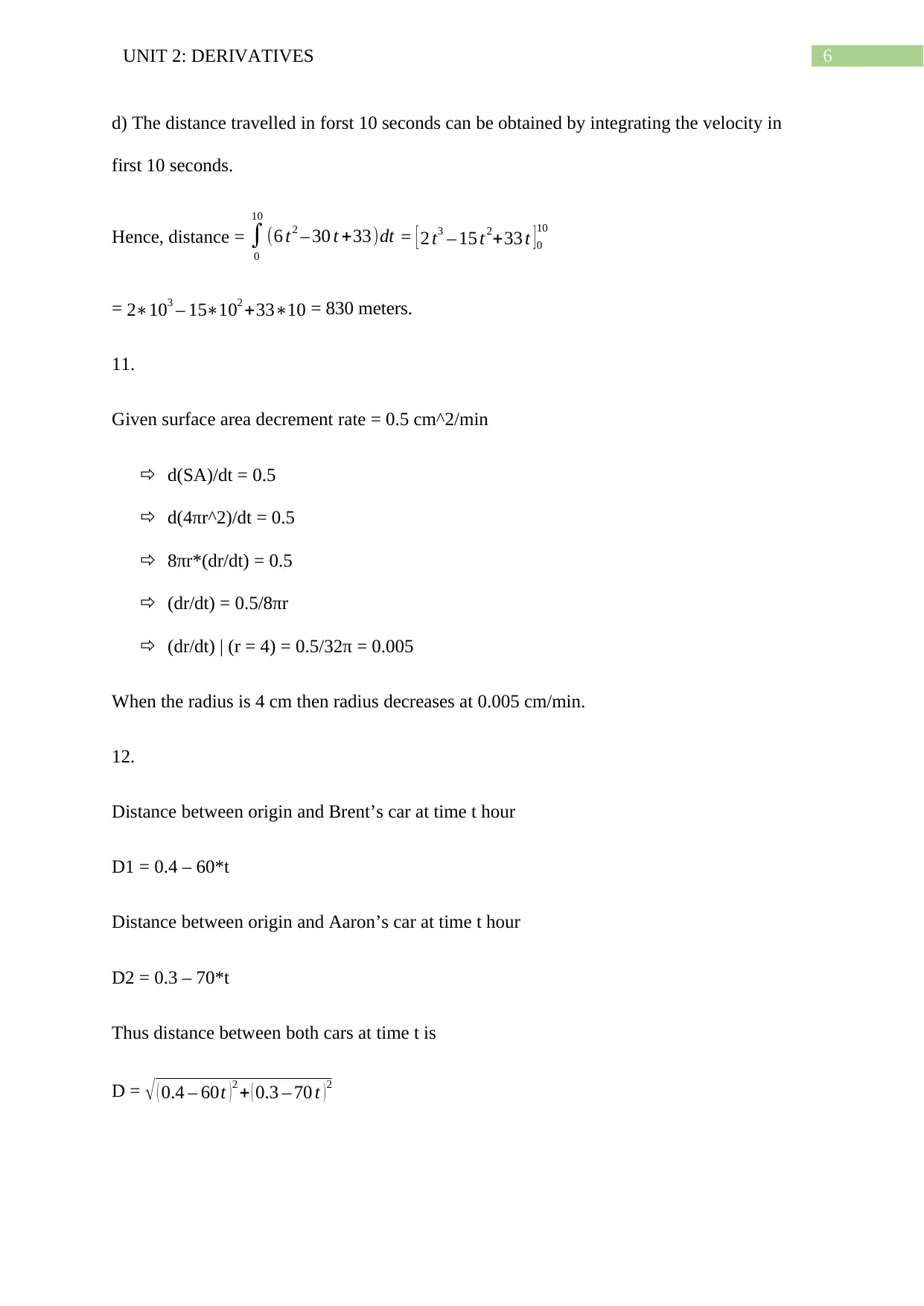
6UNIT 2: DERIVATIVES
d) The distance travelled in forst 10 seconds can be obtained by integrating the velocity in
first 10 seconds.
Hence, distance = ∫
0
10
(6 t2 – 30 t +33)dt = [ 2 t3 – 15 t2+33 t ]0
10
= 2∗103 – 15∗102 +33∗10 = 830 meters.
11.
Given surface area decrement rate = 0.5 cm^2/min
d(SA)/dt = 0.5
d(4πr^2)/dt = 0.5
8πr*(dr/dt) = 0.5
(dr/dt) = 0.5/8πr
(dr/dt) | (r = 4) = 0.5/32π = 0.005
When the radius is 4 cm then radius decreases at 0.005 cm/min.
12.
Distance between origin and Brent’s car at time t hour
D1 = 0.4 – 60*t
Distance between origin and Aaron’s car at time t hour
D2 = 0.3 – 70*t
Thus distance between both cars at time t is
D = √ ( 0.4 – 60t ) 2 + ( 0.3 – 70 t ) 2
d) The distance travelled in forst 10 seconds can be obtained by integrating the velocity in
first 10 seconds.
Hence, distance = ∫
0
10
(6 t2 – 30 t +33)dt = [ 2 t3 – 15 t2+33 t ]0
10
= 2∗103 – 15∗102 +33∗10 = 830 meters.
11.
Given surface area decrement rate = 0.5 cm^2/min
d(SA)/dt = 0.5
d(4πr^2)/dt = 0.5
8πr*(dr/dt) = 0.5
(dr/dt) = 0.5/8πr
(dr/dt) | (r = 4) = 0.5/32π = 0.005
When the radius is 4 cm then radius decreases at 0.005 cm/min.
12.
Distance between origin and Brent’s car at time t hour
D1 = 0.4 – 60*t
Distance between origin and Aaron’s car at time t hour
D2 = 0.3 – 70*t
Thus distance between both cars at time t is
D = √ ( 0.4 – 60t ) 2 + ( 0.3 – 70 t ) 2
Paraphrase This Document
Need a fresh take? Get an instant paraphrase of this document with our AI Paraphraser
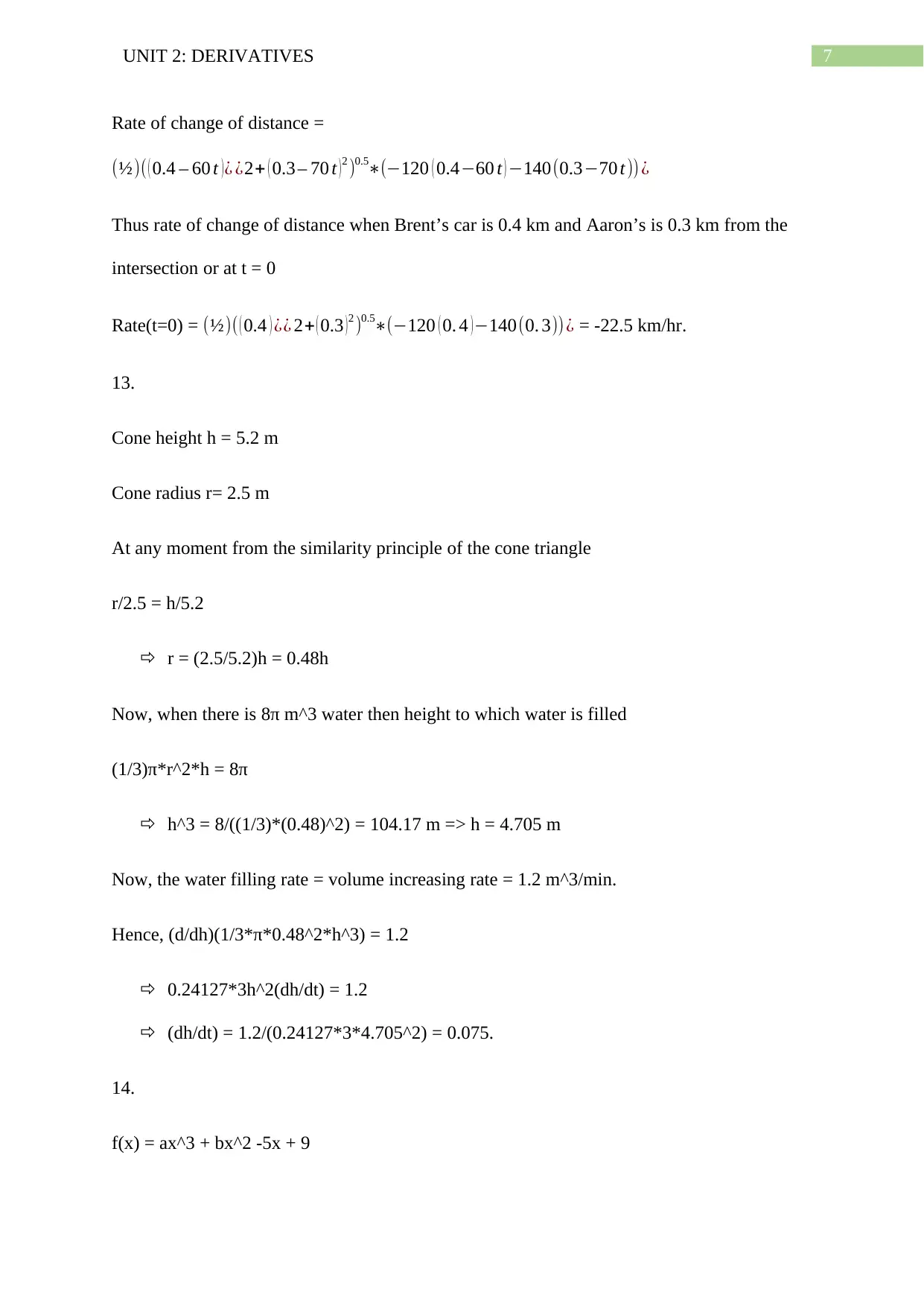
7UNIT 2: DERIVATIVES
Rate of change of distance =
(½)( ( 0.4 – 60 t )¿ ¿2+ ( 0.3 – 70 t )2 )0.5∗(−120 ( 0.4−60 t ) −140(0.3−70 t)) ¿
Thus rate of change of distance when Brent’s car is 0.4 km and Aaron’s is 0.3 km from the
intersection or at t = 0
Rate(t=0) = (½)( ( 0.4 ) ¿¿ 2+ ( 0.3 ) 2 )0.5∗(−120 ( 0. 4 ) −140(0. 3))¿ = -22.5 km/hr.
13.
Cone height h = 5.2 m
Cone radius r= 2.5 m
At any moment from the similarity principle of the cone triangle
r/2.5 = h/5.2
r = (2.5/5.2)h = 0.48h
Now, when there is 8π m^3 water then height to which water is filled
(1/3)π*r^2*h = 8π
h^3 = 8/((1/3)*(0.48)^2) = 104.17 m => h = 4.705 m
Now, the water filling rate = volume increasing rate = 1.2 m^3/min.
Hence, (d/dh)(1/3*π*0.48^2*h^3) = 1.2
0.24127*3h^2(dh/dt) = 1.2
(dh/dt) = 1.2/(0.24127*3*4.705^2) = 0.075.
14.
f(x) = ax^3 + bx^2 -5x + 9
Rate of change of distance =
(½)( ( 0.4 – 60 t )¿ ¿2+ ( 0.3 – 70 t )2 )0.5∗(−120 ( 0.4−60 t ) −140(0.3−70 t)) ¿
Thus rate of change of distance when Brent’s car is 0.4 km and Aaron’s is 0.3 km from the
intersection or at t = 0
Rate(t=0) = (½)( ( 0.4 ) ¿¿ 2+ ( 0.3 ) 2 )0.5∗(−120 ( 0. 4 ) −140(0. 3))¿ = -22.5 km/hr.
13.
Cone height h = 5.2 m
Cone radius r= 2.5 m
At any moment from the similarity principle of the cone triangle
r/2.5 = h/5.2
r = (2.5/5.2)h = 0.48h
Now, when there is 8π m^3 water then height to which water is filled
(1/3)π*r^2*h = 8π
h^3 = 8/((1/3)*(0.48)^2) = 104.17 m => h = 4.705 m
Now, the water filling rate = volume increasing rate = 1.2 m^3/min.
Hence, (d/dh)(1/3*π*0.48^2*h^3) = 1.2
0.24127*3h^2(dh/dt) = 1.2
(dh/dt) = 1.2/(0.24127*3*4.705^2) = 0.075.
14.
f(x) = ax^3 + bx^2 -5x + 9
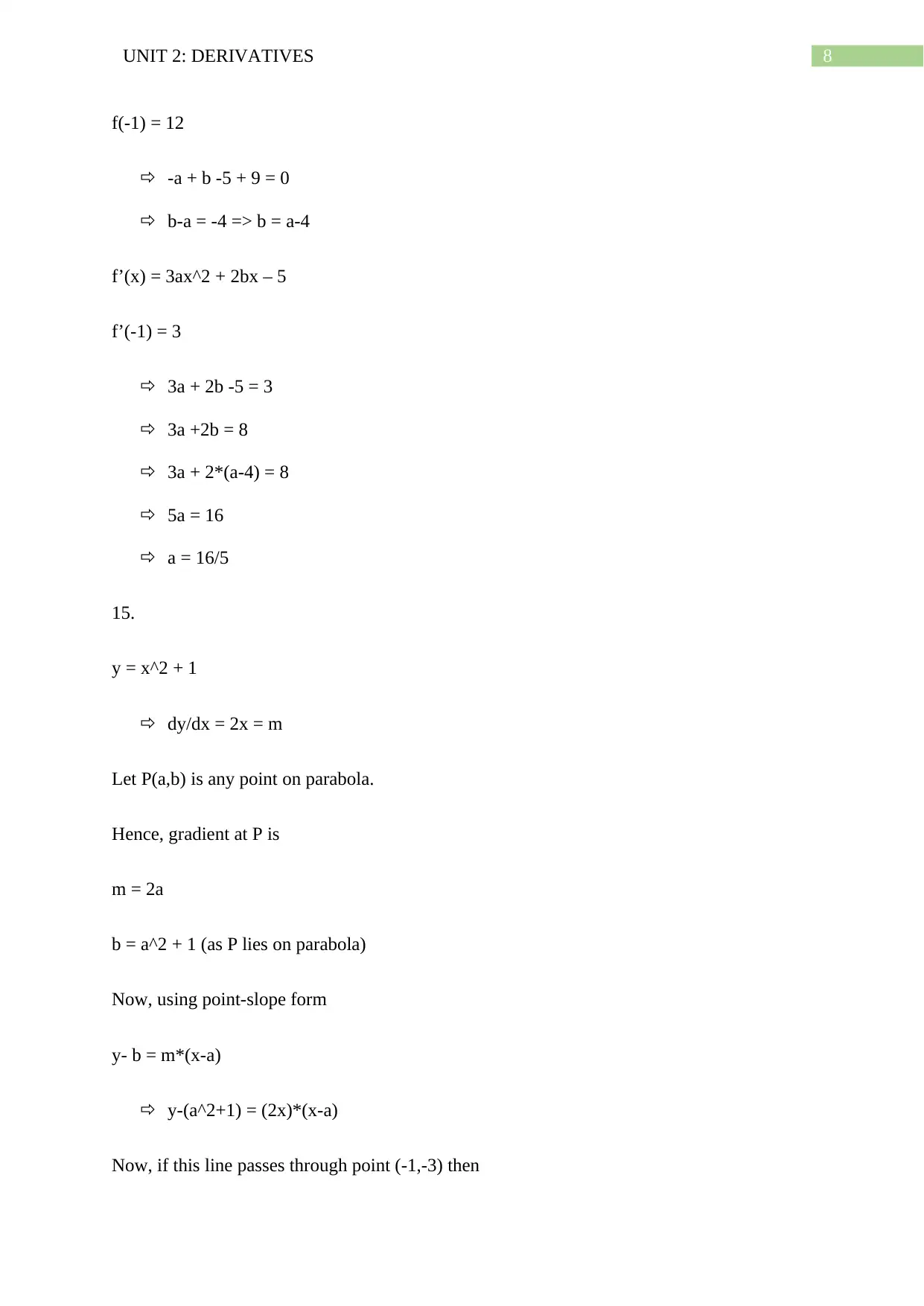
8UNIT 2: DERIVATIVES
f(-1) = 12
-a + b -5 + 9 = 0
b-a = -4 => b = a-4
f’(x) = 3ax^2 + 2bx – 5
f’(-1) = 3
3a + 2b -5 = 3
3a +2b = 8
3a + 2*(a-4) = 8
5a = 16
a = 16/5
15.
y = x^2 + 1
dy/dx = 2x = m
Let P(a,b) is any point on parabola.
Hence, gradient at P is
m = 2a
b = a^2 + 1 (as P lies on parabola)
Now, using point-slope form
y- b = m*(x-a)
y-(a^2+1) = (2x)*(x-a)
Now, if this line passes through point (-1,-3) then
f(-1) = 12
-a + b -5 + 9 = 0
b-a = -4 => b = a-4
f’(x) = 3ax^2 + 2bx – 5
f’(-1) = 3
3a + 2b -5 = 3
3a +2b = 8
3a + 2*(a-4) = 8
5a = 16
a = 16/5
15.
y = x^2 + 1
dy/dx = 2x = m
Let P(a,b) is any point on parabola.
Hence, gradient at P is
m = 2a
b = a^2 + 1 (as P lies on parabola)
Now, using point-slope form
y- b = m*(x-a)
y-(a^2+1) = (2x)*(x-a)
Now, if this line passes through point (-1,-3) then
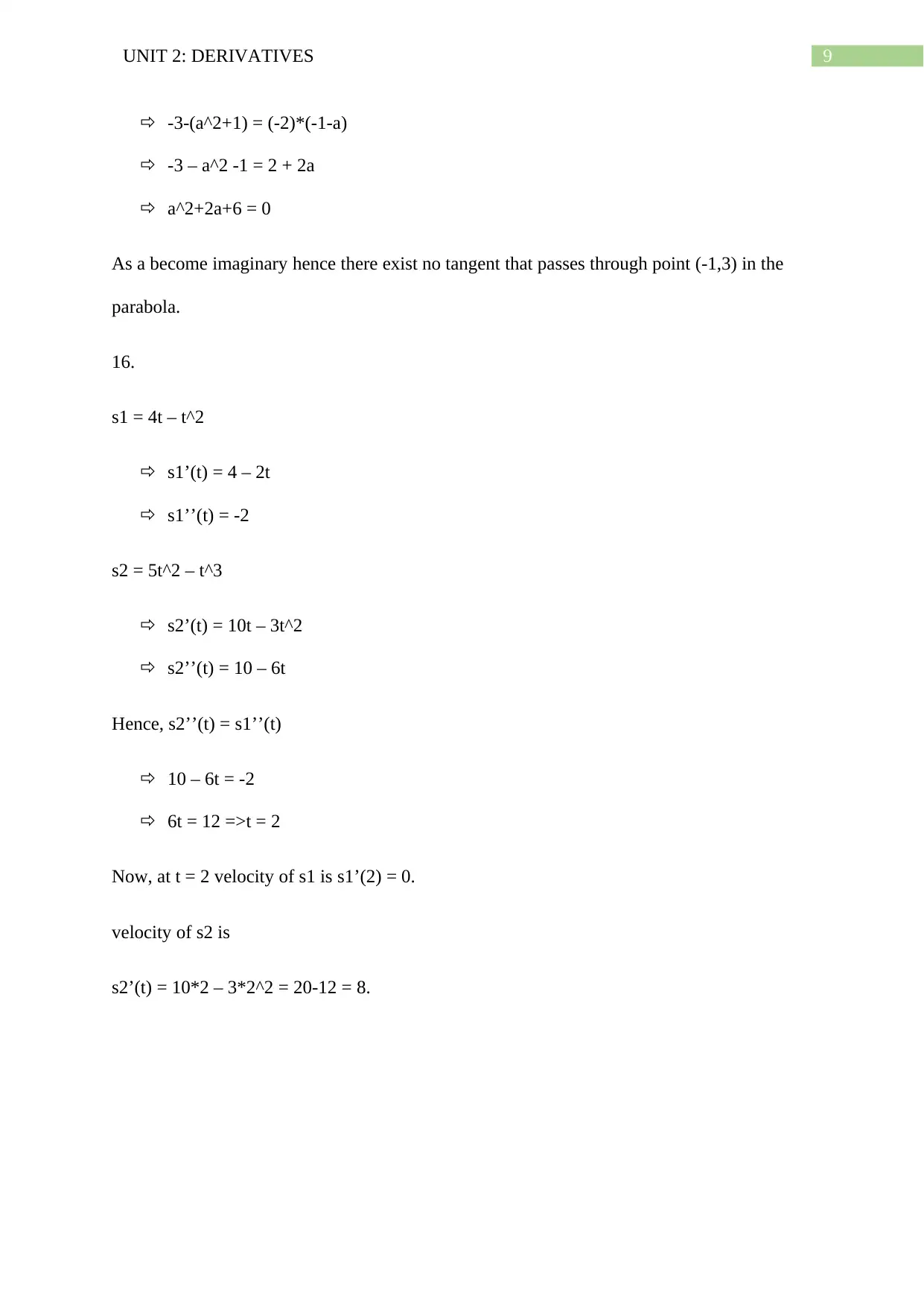
9UNIT 2: DERIVATIVES
-3-(a^2+1) = (-2)*(-1-a)
-3 – a^2 -1 = 2 + 2a
a^2+2a+6 = 0
As a become imaginary hence there exist no tangent that passes through point (-1,3) in the
parabola.
16.
s1 = 4t – t^2
s1’(t) = 4 – 2t
s1’’(t) = -2
s2 = 5t^2 – t^3
s2’(t) = 10t – 3t^2
s2’’(t) = 10 – 6t
Hence, s2’’(t) = s1’’(t)
10 – 6t = -2
6t = 12 =>t = 2
Now, at t = 2 velocity of s1 is s1’(2) = 0.
velocity of s2 is
s2’(t) = 10*2 – 3*2^2 = 20-12 = 8.
-3-(a^2+1) = (-2)*(-1-a)
-3 – a^2 -1 = 2 + 2a
a^2+2a+6 = 0
As a become imaginary hence there exist no tangent that passes through point (-1,3) in the
parabola.
16.
s1 = 4t – t^2
s1’(t) = 4 – 2t
s1’’(t) = -2
s2 = 5t^2 – t^3
s2’(t) = 10t – 3t^2
s2’’(t) = 10 – 6t
Hence, s2’’(t) = s1’’(t)
10 – 6t = -2
6t = 12 =>t = 2
Now, at t = 2 velocity of s1 is s1’(2) = 0.
velocity of s2 is
s2’(t) = 10*2 – 3*2^2 = 20-12 = 8.
Secure Best Marks with AI Grader
Need help grading? Try our AI Grader for instant feedback on your assignments.

10UNIT 2: DERIVATIVES
1 out of 11
Related Documents
Your All-in-One AI-Powered Toolkit for Academic Success.
+13062052269
info@desklib.com
Available 24*7 on WhatsApp / Email
![[object Object]](/_next/static/media/star-bottom.7253800d.svg)
Unlock your academic potential
© 2024 | Zucol Services PVT LTD | All rights reserved.





